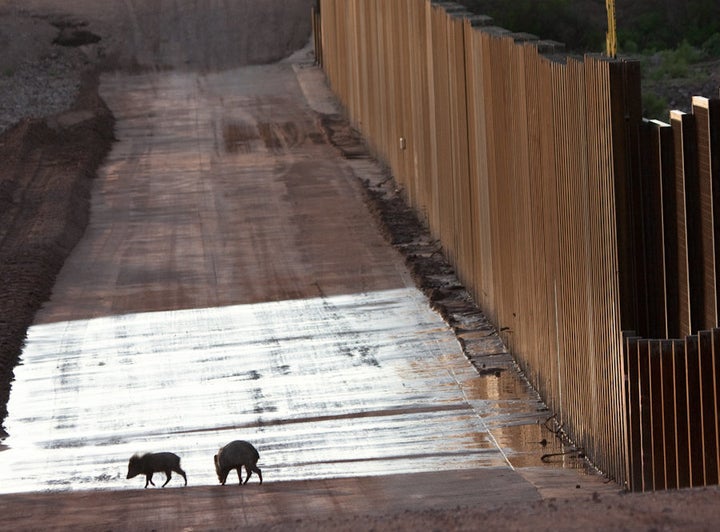
Produced by HuffPost's Eyes & Ears Citizen Journalism Unit
The building of a border wall along the Rio Grande has an unlikely victim: local wildlife.
Conservation photographer Krista Schlyer spent the last year monitoring and photographing the construction of the wall along the U.S.-Mexican border in order to document the impact.
Most of the wall was built without any regard to environmental laws. In 2005, Congress gave the Department of Homeland Security the authority to waive all laws in order to hasten construction. DHS's Michael Chertoff waived 36 laws so the wall could be built without consideration of the environment, disregarding laws like the Endangered Species Act and the National Environmental Policy Act.
Schlyer originally spent time at the border as a journalist working with a scientist on a story about a herd of bison that crosses the border of New Mexico and Chihuahua every day to look for food and water in the drought-ridden grasslands. On a research flight over Arizona, she looked down when the plane was crossing over the boot heel of New Mexico. Schlyer saw bison jumping over a barbed wire fence to get from the U.S. to Mexico.
"That moment changed my life," says Schlyer. "I got a grasp of the impact."
The future of gray wolves, jaguar, bighorn sheep and pronghorn antelopes world is in danger, and hardly anyone knows it. Seeing the animals imprisoned from crucial resources motivated Schyler to be more active by creating awareness about the situation.
Schlyer worked with the International League of Conservation Photographers to launch a website and set up an exhibit for her project, documenting the effect of the wall on the wildlife along the border. To get the photos she needed, she organized a Rapid Assessment Visual Expedition (RAVE).
For 9 months, Schlyer was alone, armed only with her camera and extreme patience. She waited for endangered species to stumble past her lens. "Sometimes I worked with scientists and they know a certain animal frequents a certain area. Sometimes you go out to a watering hole. You sit there and you get lucky," says Schlyer.
Working with borderland scientists and advocates, Schlyer toured the segments of the wall that would have the biggest impact on animals, particularly the areas where the wall cuts off water sources and migration corridors. They went to landowners on the north and south sides. The owners on the north side said the bison were there everyday -- they like the grass on his land. The south side owner described a pool of water, 100 feet from the border, where the bison like to drink every day. Schlyer knew that this meant the wall would get between the bison herd and its water source.
"It is heartbreaking for me. All of my work is wrapped up in these species. They are already in severe peril, with global warming in the area already causing prolonged drought. It is critical for the animals to be able to move. This wall is being built all the time. I watch the barrier go up and realize there's no way I could stop it. Coming to terms with that has been difficult," says Schlyer.
Last January, Schlyer returned with 13 other photographers to scout out 11 locations along the 2,000 miles of border. During the month-long RAVE expedition, they camped for ten days and then stayed with local residents on the U.S. and Mexican side of the border.
The group also spent a lot of time with residents along the border and saw how the wall was affecting them, their families, their work and their way of life. According to Schlyer, the federal government is seizing land along the Rio Grande that has been in families for as many as 10 generations in order to expand the wall.
The wall is meant to keep the illegal immigrants out of the US, but the artifacts of border crossings tell a different story.
"Ladders, ropes, and tunnels litter the borderlands now as people find a way around," she says.
Not every single mile of the 2,000 long mile stretch is covered in the solid wall, so humans can find gaps in the wall. But the animals can't. The endangered animals are cut off from their life supply, unable to find water in the already dry areas of the country and unable to hook up with mates to prevent them from becoming endangered species.
The group returned with 10,000 photos. This weekend, Schlyer showed off the photographs at the G2 gallery in Venice, as part of a traveling exhibition around the country. The photos were also included in a letter the Environmental Protection Agency's advisory board presented to President Obama.
This wall issue isn't going away.
"We're told that the border wall will be used by wall advocates as a bargaining chip in comprehensive immigration reform. They are saying if you want immigration reform, you'll have to build more wall," Schlyer says.
During the anniversary of the fall of the Berlin Wall, Schlyer's work was on display in the Russell Rotunda of the U.S. Senate in November.
"I hope that it was seen by some of the minds that need to see it so they can start thinking about all the impacts and all of the costs of the wall," she says.
Congressman Raul Grijalva introduced the Border Security and Responsibility Act 2009 to return laws to the borderland, so that laws that have been in place for hundreds of years would no longer be waived.
"But whether or not we stop building wall, we have to simply start following our own laws. Nobody should be exempt from the law, certainly not our own government," she says. "We need someone in Senate to stand up. We need a hero."